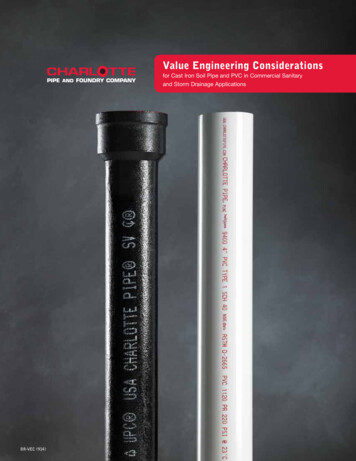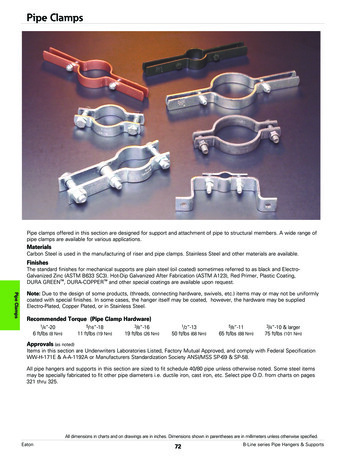
Transcription
Value Engineering Considerationsfor Cast Iron Soil Pipe and PVC in Commercial Sanitaryand Storm Drainage ApplicationsBR-VEC (914)
The CorrectMaterial forthe CorrectApplicationPlumbing design professionals, buildingowners, developers and others frequentlyface tremendous pressure to reduce buildingcosts of commercial projects. An area that iscommonly VE’d, or “Value Engineered,” isthe drain, waste and vent (DWV) plumbingsystem. Plastic materials are sometimessubstituted in place of cast iron soil pipe(CISP) where cast iron was originallyspecified—without thoughtful considerationfor the consequences of such a change.As common as this practice has become,it is sometimes lost that there were goodsolid engineering reasons that cast ironwas originally selected as the most suitablematerial for a given client or application.The objective of this brochure is to provideall of these parties a brief and objectivecomparison of the capabilities and qualitiesof each system.2
General ConsiderationsMaximum Working Temperature:Plumbing codes restrict discharges into sanitary lines to 140 F, but the reality is that commercial kitchens,condensate and equipment discharges can sometimes exceed these temperature guidelines. Consider if thatpossibility exists on the project where PVC is being substituted. PVC has a maximum working temperature of 140 F. CISP with neoprene gaskets has a maximum working temperature of 212 F.Thermal Expansion:Designers must consider thermal expansion and contraction characteristics for the piping system being used.Failure to accommodate system expansion and contraction may result in system failure. PVC will expand 3.6" per 100' of pipe with a 100 F temperature change. Compensation for thermalexpansion and contraction should be designed into systems and is generally accomplished through theuse of offsets or expansion joints. CISP will expand 0.745" per 100' of pipe with a 100 F temperature change. The movement of cast iron isclose to that of structural steel and concrete, meaning it literally “moves with the building” and usuallyrequires no compensation for expansion or contraction.Sound Attenuation:A material’s ability to block thetransmission of sound is a functionof the material’s density. Cast ironis very dense, solid-wall PVC is muchless so, and foam core materials arelighter still. Sound attenuation isespecially important in main drainagestacks and storm systems in multifamily housing, office buildings,dwellings where individuals spendthe night (hotels and hospitals) andin classroom settings. Considerhaving these two different systemsin the ceiling of your project anddecide if plumbing noise might bea consideration.The Quiet House System Noise ComparisonRule of Thumb: Most perceive a 10 dB increase in sound level as being twice as loud.3" Drain, Waste and Vent Plumbing SystemPerceived Change in “Loudness” (in decibels)Cast IronPlumbing SystemPVC Solid WallPlastic Plumbing SystemPVC Foam CorePlastic Plumbing System05101520Maintenance:Proper maintenance is requiredto keep DWV systems performingoptimally. Periodically, draincleaning devices using auger bitsare required to remove blockages.Repeated use of these devices coulddamage PVC pipe walls and fittings.3
Burial of Piping SystemsFailure Mode:The most significant difference between PVC and CISP in underground applications is the way that theysupport external loads. Defined by failure mode, piping systems are either classified as rigid or flexible. A s a flexible piping system PVC is actually dependent on the backfill and bedding surrounding the pipe tosupport it. PVC pipe must always be installed per the requirements of ASTM D 2321, which details trenchwidth, bedding depth, backfill and compaction, as well as other factors. Calculating maximum burial depthsfor flexible piping systems is very complex and requires the use of external loading software which requiresinput of many project parameters to estimate resistance to external loads. Additional information and freesoftware is available at www.uni-bell.org. Rigid piping materials like CISP fail when they crush, and specific strength charts are published irrespectiveof soil, bedding or backfill. Reference charts for burial of CISP are available in The Cast Iron Soil PipeHandbook at www.cispi.org.CAST IRONSOIL PIPECorrect burial of CISPrequires a trench onlywide enough to work in,a smooth trench bottomwith uniform support, andadequate fall and holesdug for hubs or couplings.THERMOPLASTICPIPEAs a flexible material,plastic piping is dependenton sidefill stiffness to limitdeflections. ASTM D 2321recommends a trench widthof the pipe’s outside diameterplus 16 inches, or the pipe’soutside diameter times 1.25,plus 12 inches.Considerations for Piping Systems Above GradeHanger Spacing/Fall:Properly installed DWV piping systems require consistent fall without flat or low points in the piping systemthat can impede flow. The cost of hangers, anchors and other materials plus the labor to install them is also asignificant consideration. Model Plumbing Codes require PVC DWV pipe to be supported horizontally every 4 feet. CISP offers greater structural strength, which significantly reduces hanger requirements and providesconsistent fall. CISP only needs to be supported within 18" of each joint and every 10 feet horizontally.Combustibility & Use in Plenum Spaces:Combustibility of construction materials is defined by ASTM E 136 and is a consideration for selection ofmaterials when penetrating fire-rated separations or for inclusion in un-ducted return air plenum spaces.Materials classified as combustible must pass the ASTM E 84 test protocol with index values of less than25 flame spread and 50 smoke developed. PVC, like all plastics, is classified as a combustible material per ASTM E 136. PVC has low flame spread,but smoke developed ratings may be as high as 900, so PVC will not pass the 25/50 criteria of theASTM E 84 test and may not be installed in plenum spaces. CISP is classified as non-combustible and can be installed in plenum areas without further consideration.4
COMBUSTIBLEFire Wall Penetrations:The cost and complexity of penetrating fire-ratedassemblies adds significant costs to the installationof DWV systems in commercial construction.When considering the use of combustible materialsvs. non-combustible, the additional care and costsinvolved in using combustible materials mustbe considered.Other ConsiderationsEnd of Life Recycling:While both PVC and Cast Iron Soil Pipe arecapable of being recycled at the end of theirservice life, only cast iron is routinely recycledin the United States at present. The market for post-consumer recycled PVC is not well developed in theU.S. at this time but is evolving rapidly, and in the future an increasedamount of this material will be recovered. The dominant standards forPVC pipe and fittings in the U.S. are ASTM D 2665 and ASTM F 891;these standards require that conforming products be composed of virginmaterials with zero percent recycled content. Charlotte Pipe producesRePVC conforming to ASTM F 1760 with post-industrial recycledcontent ranging from 30% to 80%, depending upon pipe diameter. CISP has an advantage in that scrap iron has significant economic valueand a well-established market and infrastructure for its recovery. CISPfrom Charlotte Pipe has been verified by the ICC Evaluation Service tobe manufactured of 95.81% post-consumer recycled content.Cellular Core PVC Pipe:Cellular or foam core PVC pipe conforming to ASTM F 891 is producedby extruding a layer of foamed PVC between two layers of solid PVC,thereby reducing the weight and cost of the product. Cellular core pipe isdesigned for drainage (non-pressure) service only. The stiffness of cellularcore pipe in most diameters is lower than that of solid-wall PVC pipe.Pipe stiffness is a key factor in determining the ability of pipe to resistexternal loads such as earth or live loads in underground installations.For this reason many specifiers believe that solid-wall PVC pipe is morerobust and better suited to the rigors of commercial construction.Extra Heavy Cast Iron:Extra Heavy (XH) hub and spigot CISP is available and preferred indemanding installations requiring the ultimate in rigidity and strength.XH is useful to designers working with applications subject to high liveor earth loads, sheer forces in filled or unstable soil, and where pipe issuspended from a slab. Charlotte Pipe and Foundry offers XH CISP anda full range of fittings up through 15" size.When combustible piping systems likePVC pipe penetrate fire-rated assemblies,fire‑stop devices or collars conforming to therequirements of ASTM E 814 and specificallylisted for use with that piping system must beused and must be installed around the PVCpipe on both sides of the fire-rated wall per therequirements of the listing.NON-COMBUSTIBLEBecause CISP is non-combustible, it willnot burn away leaving a hole in the fire-rated assembly. Therefore, installers are onlyrequired to seal the annular space betweenthe wall and the pipe when CISP penetratesfire-rated assemblies. Typically mineral woolbatting and fire-resistant caulking are used tofill the annular space.Case Study:Winnipeg AirportIn 2010, wide-spread PVC pipefailures were discovered beneaththe new 585 million WinnipegAirport, which ultimately delayedopening of the airport for manymonths and resulted in litigationthat will require months or yearsto resolve. While the cause of afailure may be unclear and maybe the result of unstable soil orpoor installation practices, thedesign and material specificationare certain to be questioned. Theultimate result is a failed systemunder many feet of concrete thatcan only be accessed by cuttingthrough the concrete or tunnelingunder the structure, all at anexorbitant cost.5
Conclusion:Give careful consideration to all aspectsof a project before “Value Engineering”CISP to PVC.6
Checklist for Cast Iron to PVC VE DiscussionItem: Maximum Working Temperature (at zero psi)YESNOYESNOYESNOYESNOYESNOYESNOYESNOWill system exceed 140 F by design or accident? Boiler condensate, comm. kitchen, washing machine, autoclaves?Fact: PVC maximum working temperature is 140 F.Fact: CISP maximum working temperature is 212 F.Item: Thermal ExpansionWhat is the air temperature at the time of installation?What is the maximum temperature of the system?What is the potential maximum change in temperature?Does contractor have expansion couplings and/or off-sets figured into bid?Access to expansion couplings for possible replacement/maintenance?Fact: PVC will expand 3.6" per 100' of pipe with a 100 F temperature change.Fact: CISP will expand .745" per 100' of pipe with a 100 F temperature change.Item: Sound AttenuationWill anyone be sleeping, convalescing, studying or working in the facility (i.e., Hotels, Dormitories, Hospitals, Schools, Libraries,Retirement, Convalescing Facilities, Shared Wall Condos & Apartments, Correctional Facilities, Quiet Work Areas, etc.)?Fact: PVC requires added insulation wrap & isolation brackets for quiet performance required in many buildings.Fact: Cast iron requires no insulation wrap because of its natural noise-dampening qualities with consistent sound performance levelsin the 25 dB range (utilizing neoprene gaskets).Item: Underground InstallationWill contractor be installing PVC with ASTM D 2321 protocol?Will contractor be supervised during installation of underground PVC to assure required trench width, trench bottom and propersoil compaction?Does contractor have proper backfill material figured into his bid?Will the DWV system be installed under concrete? Are the consequences of an underslab failure significant?Fact: As a flexible piping system PVC requires greater care in underground application. It is dependent upon the surrounding soil (soilpipe mechanism) in order to withstand an external load. PVC pipe is considered to be in a failed condition when earth or live loads havecaused the pipe to deflect beyond a certain point, generally 5%. Calculating maximum burial depths for flexible piping systems is morecomplex and requires the use of the Iowa Formula, pipe stiffness values for the system employed and knowledge of local soil conditions.Additional information of the Iowa Formula is available within the Uni-Bell Handbook of PVC Pipe.Fact: As a rigid material CISP fails when it crushes. Rigid piping systems can be evaluated with a ring crush test, and the derived valuescan be used to verify that the pipe will withstand the required external load.Item: Hanger Spacing/FallHas the cost of additional hangers and their installation been considered?Fact: Model Plumbing Codes require PVC DWV pipe to be supported horizontally every 4 feet.Fact: CISP offers greater structural strength, significantly reducing hanger requirements and providing consistent fall. Cast iron needs tobe supported within 18" of each joint and every 10 feet horizontally.Item: Plenum SpacesDoes the building utilize plenum spaces for return air?If wrapping PVC to meet ASTM E 84 is permitted by code, will a post cable/telecomm/HVAC installation inspection occur to make surepipe/fitting wrap is not damaged or disturbed?Fact: PVC should not be installed in a plenum. It is classified as a combustible material per ASTM E 136.Fact: Cast iron is a non-combustible product, which can be installed in a return air plenum.Item: Fire Wall PenetrationsHas contractor added the cost of fire-stopping materials and labor or will that be passed along to another trade?Fact: PVC requires listed fire-stop devices or collars conforming to the requirements of ASTM E 814 on both sides of the fire-rated wall.The collars utilize intumescent fire-stopping materials.Fact: Cast iron requires installers to only seal the annular space between the wall and the pipe. Typically mineral wool batting andfire-resistant caulking are used to fill the annular space.If you answered yes to any on
deflections. ASTM D 2321 recommends a trench width of the pipe’s outside diameter plus 16 inches, or the pipe’s outside diameter times 1.25, plus 12 inches. Burial of Piping Systems Failure Mode: The most significant difference between PVC and CISP in underground applications is the way that they support external loads. Defined by failure mode, piping systems are either classified as rigid or flexible.File Size: 412KBPage Count: 8











